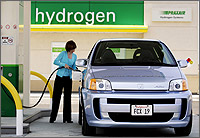By now, you’ve seen the ubiquitous, yes, ubiquitous images, scenes, photos of smoke billowing from industrial stacks; strings, lines, queues of light-, medium- and heavy-duty vehicles so concentrated, freeways and surface streets appearing parking-lot like; and smog so thick, at first glance, what’s in the air actually looks like fog.

As to the point in the middle above, in the late 1980s I used to drive from California’s Central Valley to Long Beach – a distance of approximately 250 miles – to teach classes at the state university located there. I would leave Fresno around 8 a.m. on Tuesdays and arrive in Long Beach somewhere around 12:30 p.m. for a class that began a half-hour later. In order to drive that distance in 4.5 hours’ time meant that an average speed of 55.56 miles per hour would need to be achieved. Not an easy feat. I could kiss that average speed goodbye should there be any interruptions in or disruptions to my forward momentum. And, for the return trip on Thursday afternoons, my assignment concluded at 1 p.m. and I would get back to Fresno usually anywhere between 5:30 p.m. and 7 p.m. depending.
Had I left earlier on Tuesday mornings and/or later in the afternoons on Thursdays, it would have been an entirely different story. What I would have surely been faced with are the three Cs of confines, clutches and constraints of unavoidable southland region, freeway-based, traffic congestion. That we seem to be okay with this is beyond me.
Which brings up this idea of high-occupancy/toll or HOT lanes.
So, let’s look at this HOT concept – briefly.

As it relates to bumper-to-bumper motorway traffic, this one technique, where employed, can provide limited relief to congested freeway conditions.
But enough about HOV, HOT and congestion.
Turning to the environment now, where there is driving there is air pollution, unless, of course, the vehicle being driven is a zero-emissions vehicle or ZEV. ZEVs are not only comprised of battery electric vehicles and hybrid and plug-in hybrids when operating in electric mode, the category also includes fuel-cell vehicles or perhaps more correctly, fuel-cell electric vehicles.
These vehicles indeed have come a long way compared to the early days. Since then, battery development has improved as have performance, looks, range, comfort, along with the navigational and safety features, which have not only improved but are sure to be further refined over time. Added to this, the cost to own, will likely drop too.
Recharging infrastructure, in my opinion, must become more widespread so that the fear of batteries running out of electric charge during the drive eventually and ultimately completely fades.
Moreover, where environmental impact is concerned, how the charging electricity is generated can also have an effect – positive or negative, depending on whether those supplied electrons are produced from renewable energy sources such as solar photovoltaics or wind turbines or are fossil-fuel derived.
Meanwhile, if the inclination to buy/lease and operate ZEVs continues its presently slow but steady upward ascent all the while sales/leases and use on roadways of ICE- (internal-combustion-engine-) equipped motor vehicles slumps, the net result is there will be a bump in air quality gains to, in turn, provide further environmental benefit.

The shape of things to come?
This post has been updated.
Images: Dr. Edwin P. Ewing, Jr., Centers for Disease Control and Prevention (upper); and via Wikimedia Commons (middle)